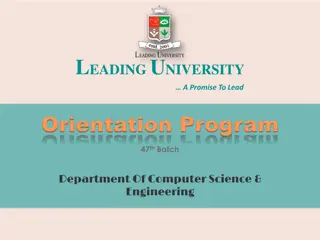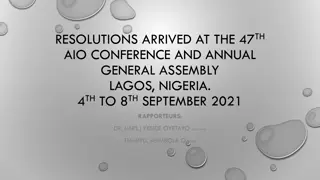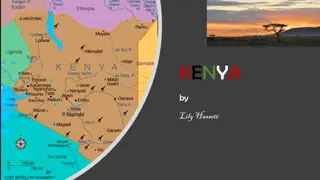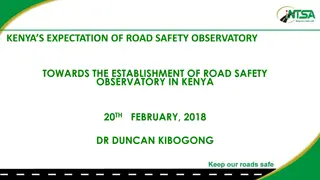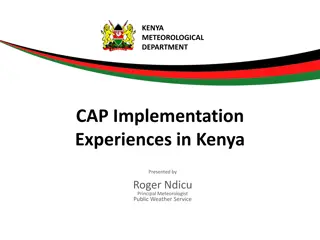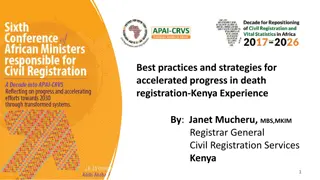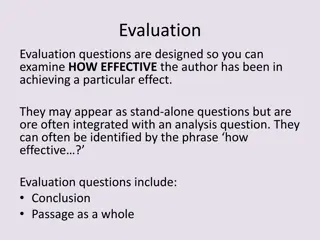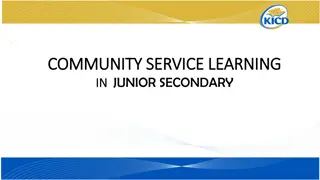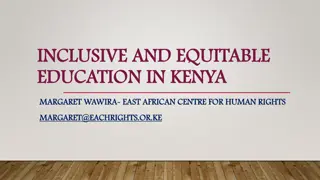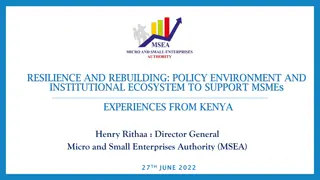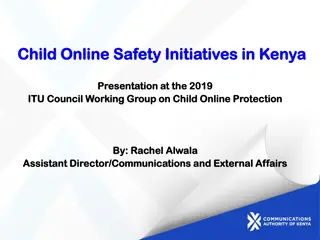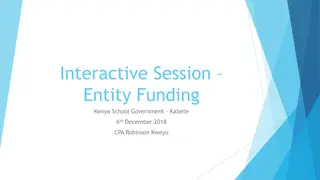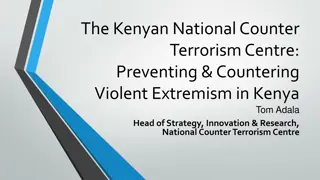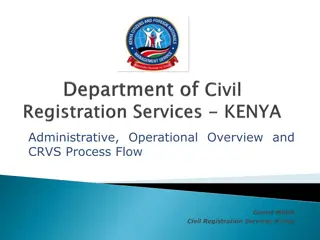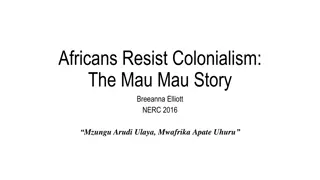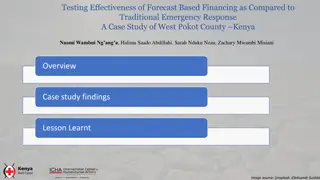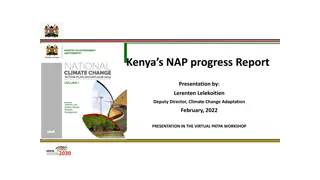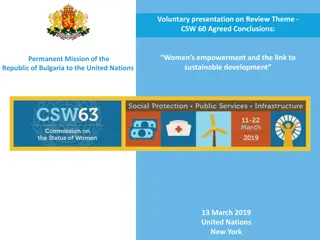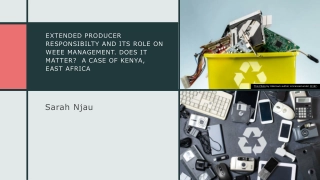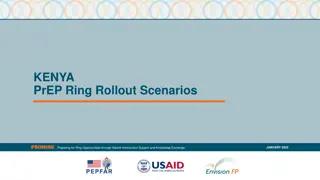Progress in Implementing CSW 47th Conclusion in Kenya
ICT plays a vital role in Kenya's national development, with initiatives aimed at empowering women and bridging the gender gap in technology usage. The country's legal and policy framework emphasizes inclusivity and optimal management of ICT. Innovations like the e-fertilizer service and mHealth are transforming the agriculture sector. Challenges remain, but Kenya is committed to advancing gender equality and leveraging ICT for societal progress.
Download Presentation

Please find below an Image/Link to download the presentation.
The content on the website is provided AS IS for your information and personal use only. It may not be sold, licensed, or shared on other websites without obtaining consent from the author. Download presentation by click this link. If you encounter any issues during the download, it is possible that the publisher has removed the file from their server.
E N D
Presentation Transcript
VOLUNTARY NATIONAL PRESENTATION KENYA S PROGRESS IN IMPLEMENTING AGREED CONCLUSION OF THE 47TH CSW Presented by: HON RACHEL SHEBESH Chief Administrative Secretary, Ministry of Public Service, Youth and Gender Affairs
Presentation Outline Introduction i. Context ii. Enabling Legal and Policy on ICT iii. Good Practices in ICT for Development in Kenya iv. Case Study- Huduma Kenya Programme v. Challenges and Opportunities vi. Way Forward vii.
Context ICT plays a key role in raising productivity, , driving innovation, efficiency, job creation, manufacturing and delivering solution to services necessary for National Development. Expansion of ICT and social media has enhanced women s participation in development conversations and shared experiences, hence a good learning platform to promote development It is also critical to governance and social development as well as promotion of gender equality. Gender parity in the use of ICT has remained low in favour of male users due to barriers caused by awareness, access costs, digital literacy, poverty and cultural barriers among others. In mobile telephony and mobile money efforts by Government of Kenya has resulted in access and use at levels almost equal amongst women and men. Penetration rate of fixed telephone has shown a narrowing gender disparity. i. ii. iii. iv. v. vi.
Enabling Legal and Policy Framework Kenya s efforts to promote access to ICT as a catalytic tool for development with potential to empower women and girls and transform gender relations in society, by providing an enabling legal and policy framework as follows: Constitution of Kenya - promotes freedom of the media and access to information and Vision 2030 recognises the critical role that ICT plays in raising productivity, wealth creation and social integration. Revised National ICT Policy 2016 ensures inclusiveness, equity, non-discrimination and partnerships seeks to improve access, resource and optimal management of ICT technologies. National Broadband Strategy promotes internet connectivity as well as lowering costs of doing business and cross border trade. National Optic fibre backbone infrastructure insulates users from threats, fraud and theft of telephones. Kenya Information Communication Amendment Act (KICA) 2013 established by Media Council as regulatory platform for arbitration of cases and complaints against the media particularly around language and gender stereotyping.
Innovations in ICT for Development in Kenya
Innovations in Using ICT E-fertilizer Service: This is an electronic-based fertilizer distribution system by MOALF in conjunction with Safaricom that avails the farm input to farmers. Issue electronic vouchers directly to farmers through their mobile phones to purchase the inputs from agro-dealers. i. MHEALTH is a mobile learning platform developed by AMREF Health Africa to conduct training of community-based health workers in Kenya. 45 mHealth services among them Daktari a mobile hotline for medical inquiries ii. AMPATH, a government service that includes SMS messaging to remind HIV patients to take their medicines. iii. M-Farm is a mobile platform for farmers: with the touch of a button, they can find prevailing prices for their produce iv. Ushahidi (Swahili for testimony) is a ground-breaking interactive mapping tool, now used across the world to crowd-source information in elections and emergencies. v.
Innovations in Using ICT M-PESA the mobile money platform that has brought financial access to millions who were left out of the traditional banking sector: these days, nine in every ten Kenyans access financial services through it. National Hospital Insurance Fund e-payment: partnership with Safaricom to allow self- employed and informally employed to pay health insurance premiums through M-pesa money platform. This service has seen more women in rural areas and informal settlements within urban areas enrolled into the healthcare insurance. GBV Hack: GBV Hack technology is used in mapping violence, gathering GBV data, using data gathered to advocate for change and providing survivors with access to essential information and support.
GOOD PRACTICES IN ICT FOR DEVELOPMENT
Good Practice-Digital Learning Programme (DLP) Initiated by the Government of Kenya in 2013. The government initiated the program out of the conviction that technology has the power to bring about systemic change in basic and higher education by transforming teaching and learning through integrating technology in the learning environment. This programme involves distribution of digital learning devices (tablets) to students and training of teachers to deliver digital based learning. In 2017, the Government installed 702,403 devices in 14,336 schools. Over 95,000 teachers have been trained to deliver digital based learning. To ensure sustainability, the Government has built capacity of local universities locally to manufacture and assemble 1,500,000 devices annually .
Good Practice-Huduma Kenya Services i. The Huduma Kenya programme is a Kenya Vision 2030 flagship project outlined in the Medium Term Plan for the period 2013 2017. ii. The Government has embarked on a Digital Government programme whose objective is to make Kenyans aspirations and dreams a reality by leveraging on technology to provide adequate access to information and transform the quality, efficiency and effectiveness of public services. iii. The Kenya Vision 2030 identifies Huduma Kenya Integrated Service Delivery Model as a global standard for Public Service innovation in service delivery iv. The programme objective is to transform the quality and efficiency in the delivery of public services by leveraging on technology to among others introduce integrated service delivery platforms such as one stop shop Huduma Centers.
Good Practice-Huduma Kenya Services One stop shop citizen service centers to provide National government services from one single location (e.g. IDs, passports, NHIF/NSSF, birth/deaths, co. ltd) Online portal to provide integrated services offered by various national government ministries, departments and agencies Mobile phone platform to offer m-government services to citizens from the convenience of their mobile phones Call center to provide customer service using a single dialing prefix that citizens can use to enquire about services offered by different government agencies Huduma Centers Huduma Web Portal Huduma Mobile Platform Huduma Call Center Unified and integratedmulti channel payment gateway to facilitate ease of payment for government services through debit cards, m-pesa, paypal etc Huduma Payment Gateway
Huduma Kenya - Background Huduma Kenya Programme is one of the Country s Vision 2030 flagship project. Launched by H.E the President in 2013 during the opening of the first Huduma Centre in Nairobi Objective is to transform public service delivery by setting high quality standards of service delivery that meet citizen expectations Governance Framework includes the Huduma Service Delivery Summit Chaired by H.E, the President, Huduma Technical Committee and the Huduma Secretariat The implementation of the programme is coordinated by Ministry of Public Service, Youth and Gender Affairs jointly with the Ministry of Interior and National Government Coordination
Huduma Kenya - Current Status There are 52 centres established since the inception of the programme and are fully operational. The Centers serve on average 42,000 people per day, and has served more 15,000,000. There are 73 services deployed to the different Huduma Services, each of the Centres provide 20-55 services from Government agencies. The Huduma Centers provide a range of 45 different Government Services offered by 28 Government Agencies. Huduma Mashinani outreaches in 141 pilot Sub Counties have reached 700,000 people in the rural areas reducing cost of services.
Huduma Kenya Benefits and innovations Integration and seamless collaboration of the 45 services deployed from 28 Ministries, Departments and Agencies government agencies present a single window to the citizen Re-engineering of services has resulted in improved efficiency and working practices Integration of back-end data and systems has led to standardisation of services delivered at Huduma Centres. Business analytics provide a monitoring framework for continuous service standards against set benchmarks Robust back-end operations ensure customers can access services with simplicity Ticket and queue systems promotes transparency and equity in service delivery for all Electronic Payment Management System facilitate transparent payment of fees/charges.
GOVERNMENT SERVICES DEPLOYED AT HUDUMA CENTRES Transforming Public Service Delivery Duplicate Identity Card HELB services Kenya Film National Cohesion and Integration Health services 1. 13. 14. 15. 16. Issuance of Birth Certificates 2. Franking of Stamp Duty Documents 3. Registration of Self Help Groups and CBOs 4. Registration of Welfare Societies Electricity services 5. 17. Name Search and Reservation Voter Registration (IEBC) 6. 18. Registration of Business Name AGPO certificate 7. 19. Issuance of Police Abstract Ombudsman EACC services 8. 20. 21. Issuance of Certificate of Good Conduct 9. NSSF services Pensions County services 10. 22. 23. NHIF services 11. Issuance of Driver s license AVERAGE OPERATIONALISATION SCORE - 67% 12.
Huduma Smart Card The card will enable Kenyans to access electronic services and make payments for public and private services 24 Hours a day 7 days a week This card will also automatically register Citizens for NHIF, NSSF and get KRA PIN at one registration point The Card will enable the Government to meet its targets on Universal Health Coverage, and support vulnerable citizens to access services and funds.
Challenges and Opportunities Opportunities Challenges Public-private growing Public-Private Partnerships (PPPs) and Kenya s largest contributor to innovation is the private sector.- revolutionized m-commerce , M- pesa. partnership: There is a i. i. Rapidly changing technological advances ii. ICT services in unserved and underserved areas remain a problem to women in the rural areas. Local innovations: A number of ICT hubs in Kenya have been established to promote the development and use of ICT technologies. ii. iii. High Telecommunication disrupts the flow of services which might reverse gains. cost and unreliability of Deployment of ICT Infrastructure Services in Counties: The Communications Authority will support licensing of providers to offer last mile access solutions. iii. iv. Limited ICT awareness that hinders cultural and attitudinal change continue to disadvantage women and girls especially in the rural areas. County-based service A wide internal digital divide between rural and urban areas. v.
Ahsante Sana! Thank You!
MINISTRY OF PUBLIC SERVICE YOUTH AND GENDER AFFAIRS GOVERNMENT OF KENYA


